Overview
Autonomous vehicles are the most significant breakthrough in the area of mobility and are set to transform the way people travel. The adoption of autonomous vehicles will revolutionized the way people commute, leading to improved road safety, reduced traffic congestion, and lower carbon emissions. The rapid development of technology in recent years has made it possible for autonomous vehicles to become a reality. The purpose of the article is to explore how the transformation of mobility in autonomous vehicles will influence society and what steps needs to be taken for a seamless and more efficient transportation system.
- Safety in Autonomous Vehicles
The primary focus of autonomous vehicles is safety, and the technology has already proven to be much safer than human-driven vehicles. Autonomous vehicles are safer because they eliminate the possibility of human error, which is the primary cause of road accidents. In addition, autonomous vehicles have a range of sensors and cameras that can detect other vehicles, pedestrians, and obstacles on the road, ensuring that the vehicles can react accordingly. Moreover, implementing autonomous vehicles will reduce the number of accidents caused by drunk driving, speeding, and reckless driving, making the road safer for everyone.
- Reduced Traffic Congestion
Autonomous vehicles will significantly reduce traffic congestion. One of the primary reasons for traffic congestion is human error, which results in stop-and-go-traffic. Autonomous vehicles can communicate with each other, allowing them to maintain a constant speed, avoid collisions, and make more efficient use of the road. This will ultimately make transportation faster and less frustrating for commuters.
The transportation sector is one of the primary contributors to global carbon emissions. The adoption of autonomous vehicles will reduce carbon emissions significantly. These vehicles are designed with electric motors, renewable energy, and optimized driving patterns that reduced the amount of energy they consume. Electric vehicles are much more efficient than traditional gasoline-powered vehicles, and using renewable energy will further reduce emissions.
Figure 1: Brief About Level of Automation for Self-driving Cars
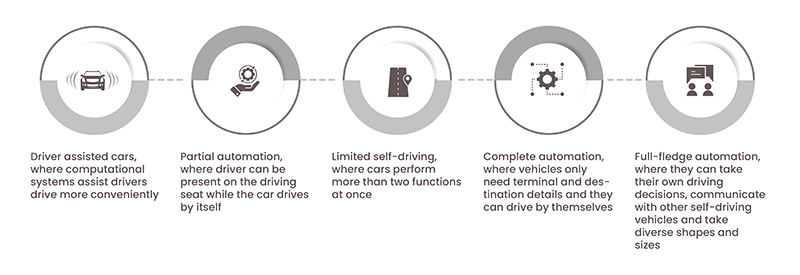
- Level 1: In level 1 category, most of the functions are still controlled by the human (the driver), but some specific functions such as steering or accelerating can be done automatically by the car
- Level 2: In level 2, at least one driver assistance system of steering and acceleration/ deceleration using information about the driving environment is automated, e.g., cruise control and lane-centering. Hence, driver starts getting disengaged from physically operating the vehicle by having his or her hands off the steering wheel and foot off the pedal at the same time. However, in this condition, the driver still should be alert and must always be ready to take control of the vehicle
- Level 3: Human drivers are still needed in level 3 cars, but can completely shift safety-critical functions to the vehicle under certain traffic or environmental conditions. It means that the driver is still present and will get involved if necessary but is not required to monitor the situation in the same way it does for the previous levels
- Level 4: Level 4 is what is meant by fully autonomous. Level 4 vehicles are designed to perform all safety-critical driving functions and monitor roadway conditions for the entire trip. However, again this is limited to the operational design domain (ODD) of the vehicle, which means that it does not cover every driving scenario
- Level 5: This level refers to a fully autonomous system in which it is expected that the 'vehicle's performance to equal that of a human driver, in every driving scenario including extreme environments like dirt roads that are unlikely to be navigated by driverless vehicles in the near future
The autonomous vehicle market has witnessed a substantial growth in recent years owing to high growth in connected vehicle technology and dynamic mobility application. In addition, the increase in need for safe, productive and efficient driving option and integrity of technology are also largely persuading the growth of the autonomous vehicle market in the above mentioned forecast period. Likewise, the rapid advances in various in-vehicle technologies and sensors are another driver anticipated to flourish the autonomous vehicle market growth. According to the Data Bridge Market Research analysis, the global autonomous vehicle market is projected to grow at a compound annual growth rate (CAGR) of 20.52% from 2021 to 2028.
To learn more about the study, visit: https://www.databridgemarketresearch.com/reports/global-autonomous-vehicle-market
Figure 2: Companies are Taking the Initiative and Investment towards the Development of Autonomous Vehicles
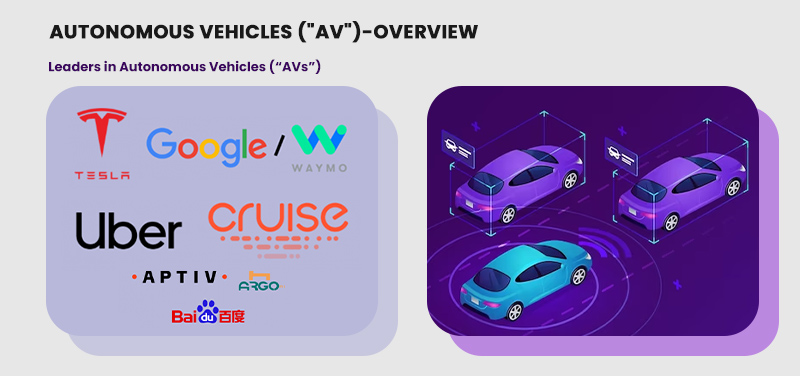
Figure: Some of the leading Players in Autonomous Vehicles
The future of mobility is rapidly changing, companies are investing heavily in the development of self-driving cars and other forms of transportation that rely on advanced technologies such AI and ML to operate. In recent news, companies have been making major strides in the mobility space, with some even taking steps to create their own autonomous driving systems.
One of the significant development in the world of mobility is the release of the first fully autonomous vehicles. Companies such as Tesla, Google, and Ford have all released vehicles that are capable of driving themselves without any human input. These cars are able to sense their surroundings and make decision based on what they detect, allowing them to navigate safely through traffic and other obstacles. This technology has been praised for its safety benefits, as it will likely reduce the number of cars accidents due to human error. It could also lead to greater convenience for drivers, who could simply enter a destination and let the car take them there.
For Instance,
- Tesla is leading the charge. In 2022, Tesla is expected to release some of the most innovative and revolutionary autonomous vehicles to data. With their cutting-edge technology and a focus on safety, these vehicles are sure to revolutionize the way to get around.
Tesla uses advanced sensors, camera, and computers, these cars will be able to interpret their surrounding and react accordingly. This will enable them to easily navigate roads, avoid obstacles, and get you from point A to point B safely and efficiently. This technology is not only making driving safer, but it will also improve the overall mobility experience. By leveraging deep learning algorithms, Tesla vehicles will be able to learn from their experience and adapt to new situations. This means that they can learn from different types of roads, traffic conditions, and weather conditions. This will lead to smoother rides as well as increased efficiency in both time and energy usage.
Tesla vehicles not only be able to learn from their experience, but they will also be able to communicate with other cars on the road, by V2V (Vehicle-to-Vehicle) communication technology. Tesla cars will be able to relay information between one another about traffic speeds, and coordinate with each other in order to make the most efficient use of the road. Tesla is also planning to introduce new ride-sharing capabilities with their vehicles in 2022. This will allow owners to share their vehicles with their users while they are away or not driving. This means that those who own Tesla vehicle can make some extra money by renting it out when not in use.
In addition to all this innovation, Tesla is also introducing new safety features into their vehicles. Their Autopilot system designed to monitor the surrounding environment in order to detect potential hazards. If a hazard is detected, it will alert the driver and take necessary action. For instance, if a pedestrian or animal is detected in front of a car, Autopilot can automatically brake or steer away to avoid an accident. All of these advances in technology have made Tesla a leader in the autonomous vehicle industry in 2022. With their cutting-edge technology and improved safety features, they will revolutionize how people get around.
- Japanese tech SoftBank's investment stood at about USD 30 billion in automotive with a focus on autonomous driving and e-hailing. With its recent investments in Cruise and Nuro.ai, SoftBank has a stake of more than USD 9 billion in autonomous driving.
- Another major development is the rise of ride-hailing services such as Uber and Lyft. These companies have revolutionized the way people get around, allowing them to quickly and conveniently order a ride from their smartphone. Uber has recently announced plans to launch its own fleet of autonomous vehicles in certain cities, allowing passengers to take a ride without a driver. Lyft has also taken steps to make its services more autonomous-friendly by launching its own self-driving division.
The development of autonomous systems has also opened up new opportunities for companies in the commercial sector.
- Automakers like Daimler have begun testing self-driving trucks that could revolutionize the trucking industry. Meanwhile, fleets of robotics delivery drones developed by Amazon and Walmart could bring goods right to 'customers' doorsteps without any human intervention. This technology could help reduce costs for businesses while increasing convenience for customers.
- Companies are working on ways to make autonomous vehicles more accessible and affordable for everyday consumers. Tesla has already released an electric car that can driver itself, while companies such as GM are developing cars with similar features that will be available at more affordable prices. This could help make autonomous cars a reality for many more people, allowing them to experience the convenience and safety benefits without breaking the bank.
- Comparing valuations shows the total market capitalization of traditional OEMs decreased by more than 10% in historic years. Meanwhile, companies in the automotive sector such as Tesla, Uber, and Waymo which are increased strongly and are increasing the valuations of traditional OEMs. 'Uber's recent valuation of more than USD 70 billion makes it more valuable than traditional premium OEMs such as BMW or Daimler. In addition, traditional OEM invest less in inorganic moves, they still hold a strong position in the Autonomous driving, Connected cars, Electrified vehicles, and Shared mobility (ACES) trends based on their patents and massive R&D expenses.
Overall, mobility in autonomous vehicles is becoming an ever-more important part of lives. Companies are investing heavily in this space and making significant strides in safety, convenience and affordability. Autonomous vehicles have the potential to revolutionize transportation by providing an efficient, safe, and accessible transport system for everyone.
The semi-autonomous and autonomous vehicle market has witnessed a substantial growth in recent years. The semi-autonomous and autonomous vehicles have many features such as engine productivity, improved fuel efficiency and minimal vehicle accidents. These are some potential benefits expected to increase the demand of these vehicles and drive the market's growth. In addition, semi-autonomous and autonomous vehicles can upsurge the efficiency of vehicles because they would deliver updates, connected vehicles and real-time traffic improved driving assistance systems. Semi-autonomous and autonomous vehicles also deliver the ability to indulge in smart driving, which aid in changing the routes accordingly. These are some of the major factors expected to create immense opportunity for the market's growth. According to the Data Bridge Market Research analysis, the global semi-autonomous and autonomous vehicle market is projected to grow at a compound annual growth rate (CAGR) of 3.80% from 2023 to 2030.
To learn more about the study, visit: https://www.databridgemarketresearch.com/reports/global-autonomous-vehicle-market
Regional Analysis
In North America, several cities have been actively incorporating autonomous vehicles into their transportation systems. For instance, Waymo, a subsidiary of Alphabet Inc., launched a public ride-hailing service with autonomous vehicles in the Phoenix metropolitan area. This initiative aims to address transportation challenges and provide convenient mobility options to residents. European countries are making significant progress in the adoption of autonomous vehicles. The U.K. government, for instance, has been investing heavily in research & development of self-driving technology. In Asia particularly in China, has emerged as one of the key player in the autonomous vehicle sector. Chinese tech companies like Baidu and Didi have invested heavily in developing autonomous mobility solutions. Baidu, for instance, has launched Apollo, an open-source autonomous driving platform, and has collaborated with several automakers to test autonomous vehicle technology on public road.
Figure 3: Total number of shared autonomous mobility in the U.S. market, by 2035 (%)
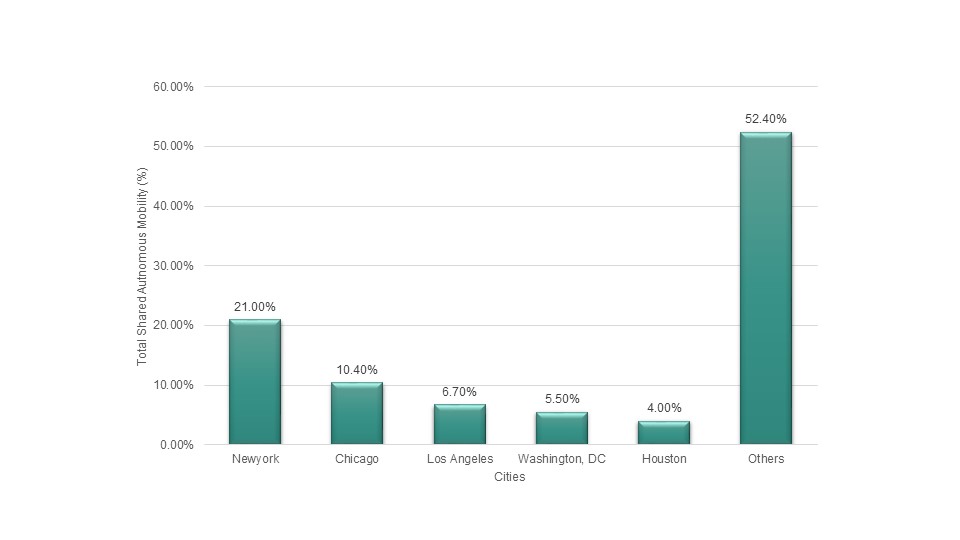
Source: International Transport Forum, Federal Transit Administration (FTA), DBMR Analysis
Figure 4: Total number of shared autonomous mobility in China market, by 2035 (%)
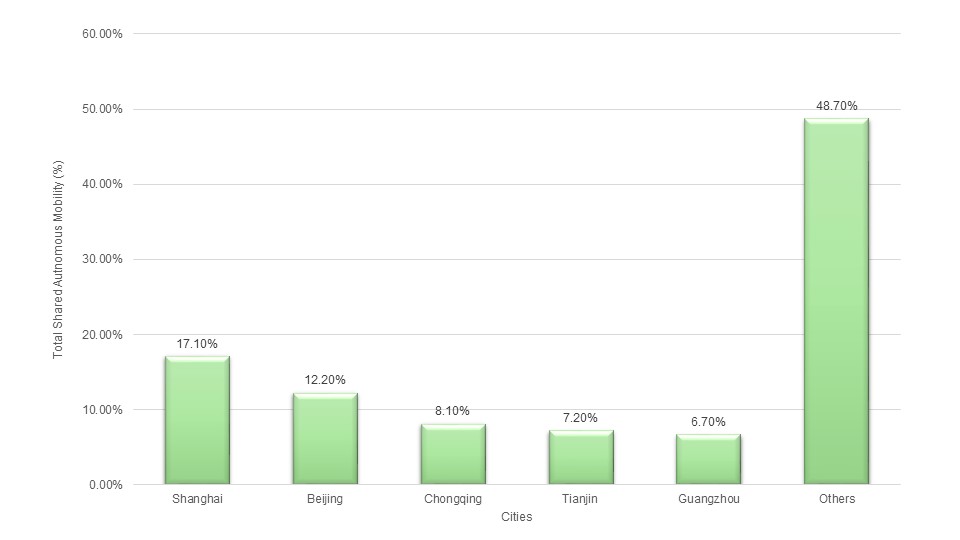
Source: International Transport Forum, Federal Transit Administration (FTA), DBMR Analysis
Figure 5: Total number of shared autonomous mobility in Europe market, by 2035 (%)
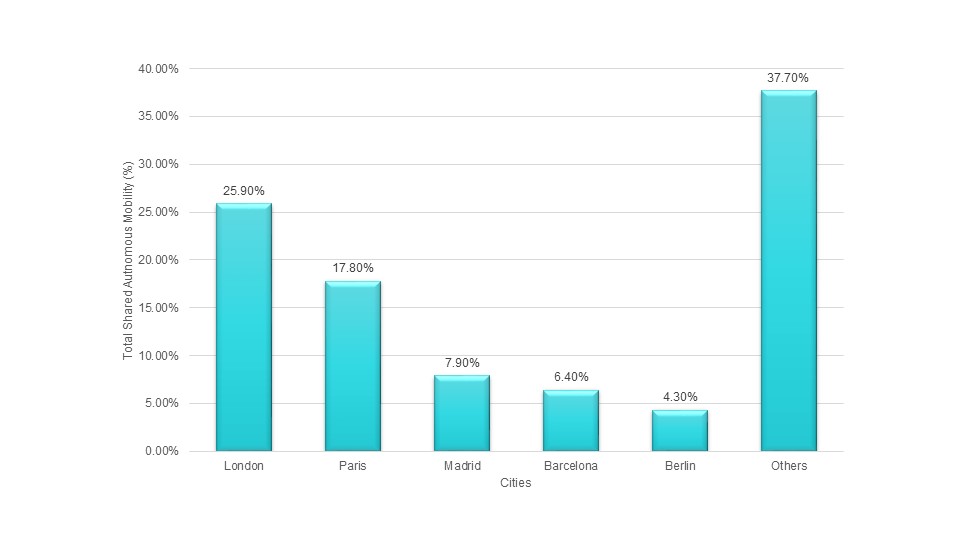
Source: International Transport Forum, Federal Transit Administration (FTA), DBMR Analysis
Overall, these regional trend indicate a growing interest in autonomous vehicles as a solution to improve mobility, reduce congestion, and enhance transportation efficiency. With ongoing advancement in technology and supportive government policies, the autonomous vehicle market is poised for significant growth in the coming years.
Figure 6: Regional variation in Investment Analysis
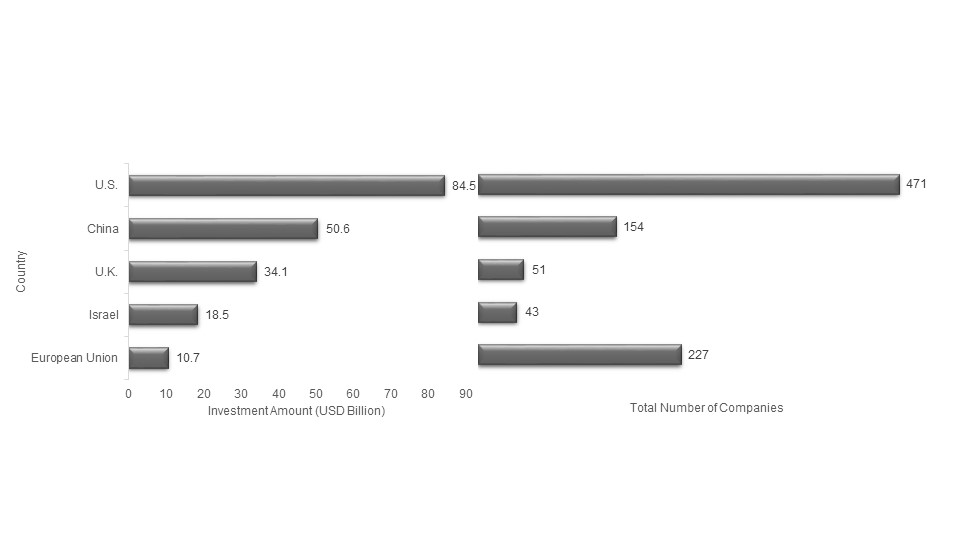
Source: International Transport Forum, Federal Transit Administration (FTA), DBMR Analysis
More than one-third of the overall investment invested in companies that focused on mobility such as in the U.S., followed by China (USD 50.6 billion), the U.K. (USD 34.1 billion), and Israel (USD 18.5 billion, where USD 17.4 billion comes from investments into Mobileye). Even though the European Union (EU), excluding the U.K., receives only 5% of global funding, it contains 19% of all identified companies. The top investors come from the U.S., Japan, and China, while the largest investor in Germany which only contributes around USD 4 billion to the European Union.
The global shared mobility market has witnessed a substantial growth in recent years owing to the wide adoption of the elegant and cost-effective mode of transport rides among customers. Therefore, growing popularity of ridesharing among consumers is likely to impel the market growth. In addition to this, the demand for the ride-hailing service model increases due to the increasing internet penetration in developing countries around the world. The rise in introduction of new types of services to ensure the customer satisfaction is also anticipated to act as a major factor for the market growth. According to the Data Bridge Market Research analysis, the global autonomous vehicle market is projected to grow at a compound annual growth rate (CAGR) of 31.18% from 2023 to 2030.
To learn more about the study, visit: https://www.databridgemarketresearch.com/reports/global-shared-mobility-market
Leading automotive manufacturers have been at the forefront of implementing mobility in the autonomous vehicles. In the full version of report, Data Bridge Market Research will provide the market size in term of value (USD Million) and Volume (Million Units). This report on the autonomous vehicles market will provide the details recent developments, trade laws, production analysis, value chain optimization, companies' market share, and the effects of domestic and regional market participants. It also examines opportunities for new revenue streams, regulatory changes, strategic market growth analysis, market size in term of value (USD Million) and Volume (Million Units), market expansions, application niches and dominance, product approvals, product launches, and geographic trends. Kindly contact with Data Bridge Market Research for an Analyst Brief to learn more about the autonomous vehicles market. DBMR will assist you in making an informed choice to grow the market.
To learn more about the study, visit: https://www.databridgemarketresearch.com/reports/global-autonomous-vehicle-market
Technology Trend in Transforming Mobility in Autonomous Vehicles
Some of the technology trends transforming mobility in autonomous vehicles. Autonomous vehicles are rapidly evolving, and it is being driven by the latest technology trends. From Artificial Intelligence (AI) to 5G to blockchain, these new technologies are revolutionizing the way people move and interact with vehicles and how they are used for transportation
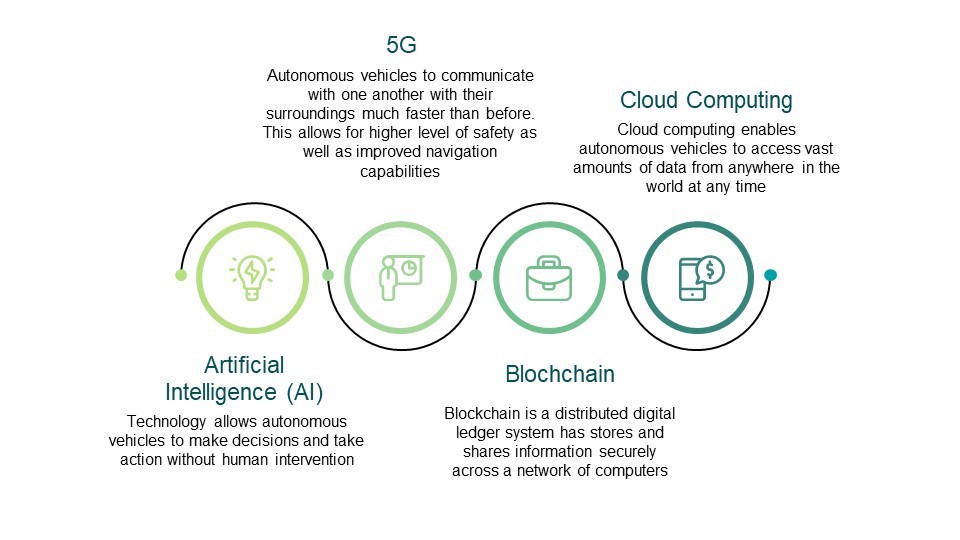
- The most revolutionary technology trend in transforming mobility in autonomous vehicles is Artificial Intelligence (AI). AI is a set of computer algorithms that can be used to interpret data sources such as sensors, cameras, and GPS data to make decisions on real-time. This type of technology allows autonomous vehicles to make decisions and take action without human intervention. AI-powered autonomous vehicles are able to detect obstacles, identify road signs, and navigator traffic better than humans. It also allows them to react more quickly than humans and be more aware of their surroundings. This make autonomous vehicles safer for passengers and other drivers on the road. Some of the most notable companies leading the development of AI-based autonomous vehicles include Tesla, Waymo, and Uber.
- The second major technology trend transforming mobility in autonomous vehicles is 5G. 5G sis 5th generation cellular network that enables faster speed and wider availability than any previous cellular technology. This make it possible for autonomous vehicles to communicate with one another with their surroundings much faster than before. This allows for a higher level of safety as well as improved navigation capabilities. Additionally, 5G networks provide low latency connections that enables more efficient use of vehicle data such as fuel consumption or road conditions. Companies like AT&T, Verizon, and Nokia are leading the way in developing 5G networks for autonomous vehicles
- The third major technology trend transforming mobility in autonomous vehicles is blockchain. Blockchain is a distributed digital ledger system has stores and shares information securely across a network of computers. This technology can be used to securely store vehicle data such as maintenance records or driver profiles. Additionally, blockchain-based systems can facilitate ride payments or allow passengers to verify their identity when getting into an autonomous vehicle. Companies like IBM, Microsoft, and Volkswagen are leading the way in developing blockchain systems for use in autonomous vehicles.
- The fourth major technology trend transforming mobility in autonomous vehicles is cloud computing. Cloud computing enables autonomous vehicles to access vast amounts of data from anywhere in the world anytime. This allows for improved communication between different elements of an autonomous vehicle system such as sensor or communication systems. Companies such as Amazon, Google, and Microsoft are leading the way in developing cloud-based systems for use in autonomous vehicles.
These above mention four major technology trend are driving rapid advancements on autonomous vehicle technology and transforming how people move around the world today. As these technologies become more advanced, they will continuously improve the safety, efficiency, and convenience of transportation for all users. Autonomous vehicles powered by AI, 5G, blockchain, and cloud computing will revolutionize how people move around the world in the coming years.
Some of the Challenges in Designing a Fully Autonomous System for Driverless Cars
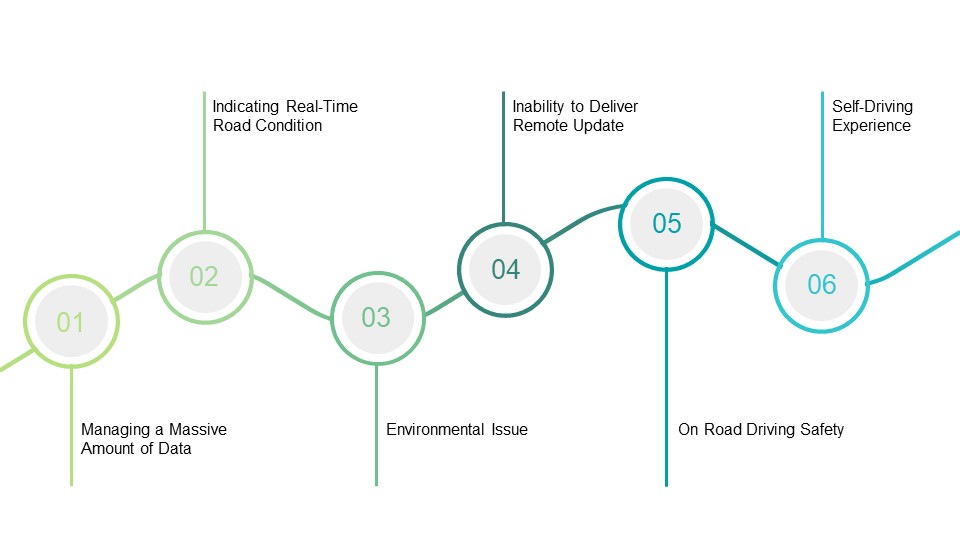
- Indicating Real-Time Road Condition
The opportunities on the road are limitless it is humanly impossible to be ready for every one of them. In this instance, Iit is technically impossible to train an algorithm to prepare for circumstances. To train the systems how to react to various road circumstances so that no objects or lives are destroyed in any given circumstance is one of the most challenging tasks. An autonomous vehicle should be able to recognize and react to a variety of situations, such as cornering, sudden congestion of vehicles on motorways, unusual wildlife or animal crossings, distressed pedestrians attempting to cross the street, potholes and poor road conditions, closed roads, and roads undergoing construction. One of the biggest challenge is that vehicles only have a few seconds to perceive road conditions and make the right decisions.
Apart from road conditions, self-driving cars must also be aware of environmental conditions and adjust their driving decisions and strategies accordingly. For example, self-driving cars should automatically detect rainfall and limit driving at low speeds to avoid accidents caused by friction. Vehicle also need to be aware of similar weather changes and make timely decisions to ensure a smooth ride. The other is the case where the car judges the outside temperature and automatically adjusts the temperature of the air conditioner.
- Inability to Deliver Remote Update
For smooth, uninterrupted driving, self-driving cars must always have up-to-date information on various factors, as mentioned earlier. If even one update does not reach the system, it will affect the entire vehicle's ability to make decisions, with unnecessary consequences. For example, if the navigation system does not receive information about upcoming road closures, the vehicle may assume the road is clear and continue accelerating toward it. It can cause a collision, resulting in personal injury or property damage. A similar situation can occur if the vehicle does not receive up-to-date information about pedestrians crossing or vehicles turning.
Autonomous cars would have to get onto the road where they would have to drive in all sorts of traffic conditions. Traffic could be highly moderated and self-regulated. However, often there are cases where people may be breaking traffic rules. An object may turn up in unexpected conditions. One cannot wait endlessly for traffic to clear and have some precondition to start moving automatically. If more of such cars are waiting for traffic to get cleared, that may ultimately result in a traffic deadlock.
One of the important things that drivers need to act in time, safety is a major challenge in operating self-driving cars. Not all self-driving cars tried and tested are fully self-driving. They have manual intervention modules. With confidence in self-driving cars still relatively low, 70% of drivers want manual brakes to be installed on self-driving cars. This is important because self-driving cars comprise a network of interdependent gadgets and devices, and there is an overall belief that each module will do its job.
The most important aspect of autonomous cars is accident liability. In the case of autonomous cars, the software will be the main component that will drive the car and will make all the important decisions. While the initial designs have a person physically placed behind the steering wheel, newer designs showcased by Google, do not have a dashboard and a steering wheel!
In such designs, where the car does not have any controls a steering wheel, brake pedal, or accelerator pedal, how is the person in the car supposed to control the car in case of an unfortunate incident? Additionally, due to the nature of autonomous cars, the occupants will mostly be in a relaxed state and may not be paying close attention to the traffic conditions. In situations where their attention is needed, by the time they need to act, it may be too late to avert the situation.
The experience of sitting in a self-driving car should be as seamless as driving a conventional car. This means self-driving cars must retain all the complexity of generating and processing data on the backend to remain seamless for drivers and passengers. Slowing the vehicle every time additional good data is needed to take action is life-threatening on the road. Self-driving cars need to feel like they have a trusted driver at the pedals.
Autonomous cars use lasers and radar for navigation. The lasers are mounted on rooftop while the sensors are mounted on the body of the vehicle. The radar principle works by detecting radio wave reflections from surrounding objects. When on the road, a car will continuously emit radio frequency waves, which get reflected from the surrounding cars and other objects near the road. The time taken for the reflection is measured to calculate the distance between the car and the object. Appropriate action is then taken based on the radar readings. The radar principle works by detecting radio wave reflections from surrounding objects. When on the road, a car will continuously emit radio frequency waves, which get reflected from the surrounding cars and other objects near the road. The time taken for the reflection is measured to calculate the distance between the car and the object. Appropriate action is then taken based on the radar readings. When this technology is used for hundreds of vehicles on the road, will a car distinguish between its own (reflected) signal and the signal (reflected or transmitted) from another vehicle? Even if multiple radio frequencies are available for radar, this frequency range is unlikely to be insufficient for all the vehicles manufactured.
- Managing Massive Amount of Data:
This is probably the biggest challenge in this area. Self-driving cars generate and process vast amounts of data every second. Many sensors and devices operate extensively to detect and produce data from the environment. These include LIDAR, RADAR, SONAR, GPS, and computer vision. A self-driving car could generate up to 100 (TB) terabytes of data when drives for 8 hours. The result is the need for large amounts of cloud storage, transmission, and processing power with near 100% availability at all times. All these functions must be at the highest level for the vehicle to work meaningfully.
- Solution to Overcome Challenges of Autonomous Vehicles
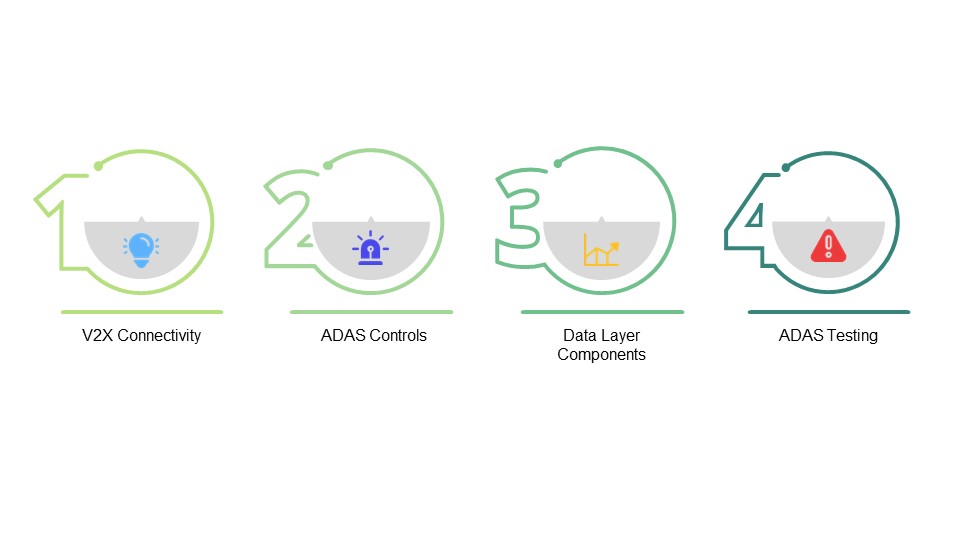
V2X connectivity means that a car can connect with its surroundings and other cars. V2X technology greatly helps self-driving cars by allowing them to detect objects and elements in the surrounding area, which reduces risks while driving. V2X can also work together with telematics to process data more efficiently. Moreover, it also changes between different operational modes to continuously transmit and receive the right information. V2X connectivity has a great feature that uses industry-standard encryption protocols to secure all the data it generates and its embedded systems.
ADAS controls help self-driving cars make the best driving choices using precise information. This means finding the best route without much traffic, parking easily in small spaces, noticing people walking and traffic lights from far away, knowing what the weather will do, and other things.
In basic terms, data layer components are parts of an application that allow access to data stored in persistent storage like the cloud. This allows modules to use commonly needed data for processing immediately. This means that it reduces the creation of unnecessary duplicate information.
ADAS testing allows vehicles to store driving decisions even before they start driving on the road. This is because these algorithms tested many times in different conditions to learn and adjust themselves. ADAS modules are ready to work well and accurately to detect things. They keep getting better even after they start using them on the road.
Conclusion and the Future
The transformation of mobility in autonomous vehicles can potentially bring about significant changes to the transportation system. Autonomous vehicles will reduce traffic congestion, improve road safety, and reduce carbon emissions, making transportation more efficient, cost-effective, and environmentally friendly. However, the transformation requires coordinated efforts from vehicle manufacturers, technology companies, policymakers, and regulators to ensure that the necessary infrastructure is created, communication protocols are developed, and a regulatory framework is established, enabling the seamless integration of autonomous vehicles. The future of transportation in autonomous, and it is time to embrace this technology and its benefits.








